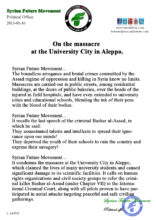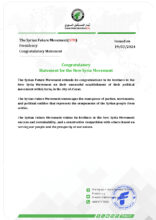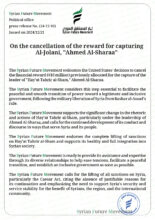A Reading into Assad’s Positioning within the Axis of Resistance

Introduction:
It can be assumed that the relationship between Syria and Iran has always had a strategic dimension, evolving in various ways between the rule of Hafez al-Assad and Bashar al-Assad.
When Hafez al-Assad assumed power in Syria, relations with Iran were characterized by a strategic alliance, which became evident after the Islamic Revolution in Iran in 1979. Hafez al-Assad was among the first Arab leaders to support the Iranian Revolution. During the Iran-Iraq War, Syria was one of the few Arab countries that backed Iran against Iraq, strengthening ties between the two nations. Hafez al-Assad also provided military support to Iran, including training Iranian forces in the use of Scud missiles.
With Bashar al-Assad’s rise to power, the strategic relationship between Syria and Iran persisted and even grew stronger. Bashar al-Assad faced significant internal and external challenges, including the popular uprising in 2011. During this period, Iran played a vital role in supporting Bashar al-Assad’s regime, offering critical military, economic, and political support that enabled the regime to endure despite the considerable challenges it faced.
Development of the Relationship:
In general, it can be said that the relationship between “Assad’s Syria” and “Iran” has always been strong, active, and strategically influential. However, it deepened and expanded further under Bashar al-Assad due to the circumstances and challenges faced by the Syrian regime. These factors allowed Iran to infiltrate the very structure of the Syrian regime, particularly the Syrian army and its key components. Globally, the Syrian regime was permitted to breathe through Iran’s unparalleled support, which formed the base of a triangular strategy: Russian aerial support on one side, the movement of Assad’s forces across Syrian geography on another, and Iranian backing as a critical pillar. Iran thus became a principal supporter of the Syrian regime during the Syrian war and a major player on the ground.
Initially, Iran provided substantial military and financial support to the Syrian regime, including sending various Shiite militias affiliated with the so-called “Axis of Resistance,” most notably Hezbollah in Lebanon. Over time, this relationship expanded to encompass economic and political dimensions. Iran invested in several sectors of the Syrian economy, such as oil and phosphate, and signed long-term cooperation agreements to enhance its economic and political influence in the country.
In recent years, the region has witnessed diplomatic and geopolitical shifts, such as Syria’s return to the Arab League in May 2023 and improved relations between Iran and Saudi Arabia in March 2023. These developments have undoubtedly strengthened the position of Iran and Syria as strategic allies in the region.
Strategic Treaties:
The most important treaties between Iran and the Syrian regime include the long-term strategic economic cooperation agreement signed in July 2024, which spans 20 years and includes Syria’s repayment of its debts to Iran. The agreement also aims to strengthen cooperation in multiple fields such as agriculture, oil, transport, free zones, and telecommunications. In May 2023, the late Iranian president Ibrahim Raisi and Syrian regime president Bashar al-Assad signed a memorandum of understanding for a comprehensive long-term strategic cooperation plan, which included several agreements in agriculture, oil, transport, free zones, and telecommunications.
Additionally, the comprehensive cooperation agreement between Iran and Syria, signed in May 2023, covers several strategic areas aimed at enhancing the economic and political relations between the two countries. The key details of this agreement include:
- Agriculture: Enhancing cooperation in agriculture through the exchange of expertise and agricultural technology, and increasing investments in joint agricultural projects.
- Oil and Energy: Developing joint projects in the oil and gas sector, including exploration, production, and refining, as well as improving energy infrastructure.
- Transport: Improving and developing land, sea, and air transport networks between the two countries, including the creation and updating of roads, ports, and airports.
- Free Zones: Establishing joint free zones to promote trade and investment between the two countries, and facilitate the movement of goods and services.
- Telecommunications: Strengthening cooperation in telecommunications and information technology, including the development of digital infrastructure and the exchange of technical knowledge.
This agreement aims to strengthen economic and political integration between Iran and Syria and provide a long-term framework for cooperation in various fields. As such, the comprehensive cooperation agreement between Iran and Syria could affect relations between Iran and neighboring countries in several ways:
- Enhancing Iranian Influence: This agreement may enhance Iran’s influence in the region, which could raise concerns among neighboring countries that view the expansion of Iranian influence as a threat to their interests.
- Regional Tensions: The agreement could increase tensions with countries that oppose Iranian influence in Syria, such as Israel and some Gulf states.
- Economic Cooperation: On the other hand, the agreement may open the door for new economic cooperation opportunities between Iran and neighboring countries that seek to benefit from investments and joint projects.
- Geopolitical Balances: The agreement may impact the geopolitical balances in the region, with some countries possibly seeking to strengthen their relations with Iran and Syria to face common challenges.
In general, the impact of this agreement will depend on how neighboring countries react to the new shifts in Iranian-Syrian relations, especially after the military escalation between Iran and Israel.
However, if we are to evaluate whether the comprehensive cooperation agreement between Iran and Syria is an equal partnership or an exploitation agreement, this depends on the perspective and political-economic analysis. Perhaps the most important points that can help in understanding this context are:
A. Equal Partnership:
- Shared Interests: Both countries seek to enhance their economic and political stability, making cooperation beneficial for both sides.
- Economic Integration: The agreement covers multiple areas such as agriculture, oil, and transport, which could boost economic development in both countries.
- Strategic Cooperation: The agreement provides a long-term framework for cooperation, reflecting both parties’ desire to build a sustainable relationship.
B. Exploitation Agreement:
- Iranian Influence: Some may view Iran as exploiting Syria’s difficult economic and political situation to increase its influence in the region.
- Debts and Investments: The agreement includes Syria’s repayment of debts to Iran, which could be interpreted as exploiting Syria’s financial hardship.
- Political Dependency: The agreement could increase Syria’s political and economic dependence on Iran, which might be seen as exploitation.
In the end, the evaluation depends on how the agreement is implemented and its actual impact on both countries. Therefore, we see that whether this agreement is a sign of partnership or a means of exploitation, it underscores the depth of the relationship between the two parties, making separation between them almost impossible.
Ain Dawood:
It seems that Israel views the comprehensive cooperation agreement between Iran and Syria with great concern, for several reasons:
- Strengthening Iranian Influence: Israel considers the enhancement of Iranian influence in Syria as a direct threat to its national security, especially with Iranian forces and Iran-backed militias positioned near its borders.
- Military Threat: Israel fears that Iran might use this agreement to bolster its military capabilities in Syria, increasing the likelihood of military confrontations between the two sides.
- Regional Balance: Israel believes that this agreement could shift the regional balance in favor of Iran and its allies, raising tensions in the region.
Based on these concerns, Israel may seek to strengthen its alliances with other countries in the region to counter the growing Iranian influence.
In response to the comprehensive cooperation agreement between Iran and Syria, Israel may take several steps to enhance its national security and counter the growing Iranian influence in the region. Among these steps:
- Intensifying Airstrikes: Israel is likely to increase the frequency of airstrikes on Iranian and Syrian sites it deems as threats, such as Iran-backed militia bases and weapon depots.
- Strengthening Regional Alliances: Israel may seek to bolster its relations with other countries in the region, such as the Gulf states or Turkey, to form a united front against Iranian influence, even if unofficially. This could include intelligence and military cooperation, despite improved relations between Iran and the Gulf states, as well as Turkey.
- Diplomatic Pressure: Israel might use diplomatic channels to pressure the international community, particularly the United States and Europe, to impose additional sanctions on Iran and Syria or take other diplomatic steps to limit Iran’s influence. This may involve continuing sanctions on the Syrian regime and rolling back any efforts to rehabilitate it.
- Strengthening Internal Defenses: Israel may work on enhancing its internal defenses, including improving air defense systems and developing new technologies to counter potential threats from missiles and drones.
These steps, among others, remain a means to one goal: protecting Israel’s security and addressing the challenges posed by the Iranian-Syrian agreement.
If Israel takes escalatory steps in response to the comprehensive cooperation agreement between Iran and Syria, the expected reactions from Iran and Syria may be as follows:
- Strengthening Military Cooperation: Iran and Syria may enhance their military cooperation, including increasing Iranian military support to Syria, intensifying the presence of Iran-backed militias in the region, and countering Israeli missile capabilities with long-term threats to Israel by deploying their militias and pushing them towards the southern borders.
- Reciprocal Response: Iran and Syria might respond to any Israeli strikes by launching missile attacks or using drones against Israeli targets, as has happened in previous instances. Iran may also employ internationally banned weapons, which could explode upon being intercepted by Israel’s Iron Dome, releasing prohibited materials inside Israeli territory.
- Diplomatic Escalation: Iran and Syria may escalate diplomatically by filing complaints with the United Nations and other international organizations, seeking international support against what they consider Israeli aggression. This, combined with a possible decision by the International Criminal Court, could pressure Israel’s international support in the face of Iran and the Syrian regime.
- Enhancing Regional Alliances: Iran and Syria may seek to strengthen their alliances with other regional powers, such as Russia and Turkey, to form a united front against Israel, thereby increasing pressure on it. This could also symbolize the potential for a hybrid war that could disrupt the regional status quo.
These responses, among others, will aim to counter any Israeli threats and preserve the interests of Iran and the Assad regime in the region.
The question of the possibility of severing ties:
The possibility of the Syrian regime severing its ties with Iran depends on several complex political and strategic factors.
The most important factors, as we see them, include:
- Military and Economic Dependence: The Syrian regime heavily relies on military and economic support from Iran, especially during the Syrian war years. Severing this connection could expose the Syrian regime to significant risks, including the loss of vital support for its survival.
- International and Regional Pressures: There are international and regional pressures on the Syrian regime to reduce Iran’s influence in Syria. Some Arab and Western countries might offer incentives to the Syrian regime, such as economic aid or easing sanctions, in exchange for diminishing this influence.
- Geopolitical Balances: The Syrian regime seeks to play off the contradictions between major powers in the region, such as Russia, Iran, and the United States. Severing ties with Iran might require the Syrian regime to strengthen its relationships with other powers to compensate for this loss.
- Implementation Capacity: Even if there is political will to sever ties, the ability to execute this depends on how capable the Syrian regime is of withstanding internal and external pressures, as well as Iran’s willingness to relinquish its influence in Syria.
In general, severing ties between the Syrian regime and Iran represents a significant challenge that requires drastic changes in political and regional alliances. The Syrian regime is considered a cornerstone of the entire axis of resistance, not just a mere ally.
There are several reasons that explain this role:
- Long History of Support: Syria has always been a key supporter of resistance movements in the region, such as Hezbollah in Lebanon and Hamas in Palestine. This support has spanned decades and reflects a long-term strategic commitment. In fact, the Syrian regime’s structure has been built around this narrative, and changing it would imply an internal upheaval that is difficult to accept, at least in theory, at this time.
- Geographical Location: Syria’s geographical location makes it a pivotal player in any regional alliance. Its proximity to Israel and Lebanon makes it a crucial strategic base for the axis of resistance. Losing this role would mean losing the axis unless it is restructured in a different way. There are signs that Iraq is being groomed as a strong candidate to play this role in the future, which has prompted the U.S. and Israel to send clear messages to the Iraqi regime to exercise caution.
- Iranian Support: The close relationship between the Syrian regime and Iran enhances Syria’s role as a key member of the axis of resistance. Iran provides significant military and economic support to Syria, boosting its ability to confront regional challenges.
- Shared Challenges: The Syrian regime faces the same challenges as the resistance movements, such as international pressures and economic sanctions. This makes cooperation between the two essential for facing these challenges collectively.
Conclusion:
There is a belief among some that the Syrian regime could withdraw from the axis of resistance, seeing its connection as pragmatic rather than a fateful, ideological bond. According to this view, a few promises or warnings could entice the regime to detach from the axis. However, the reality, history, and future analysis lead us to reject this belief. The Syrian regime does not have the capacity to overturn its exclusionary and singular structure, which enables it to position itself politically in Syria’s future. Nor does it have the ability to break its fateful alliance with Iran. Syria’s Foreign Minister has affirmed from Tehran that breaking away from the axis is impossible. In fact, we observe a deepening of shared strategic agreements.
Finally, the axis of resistance cannot exist without Assad’s Syria. Any shift by Assad himself against the axis would be an existential threat to the entire axis, as well as a direct threat to the collapse of the Assad regime itself. However, we also foresee that a profound and structural change will occur in the coming days across the entire axis of resistance. This transformation will take years before its new, refined, and distilled version becomes clear and accepted in the region. Until then, the Syrian regime will remain a crucial pillar in the axis of resistance and defiance. Iran will not easily relinquish its gains in Syria. Therefore, any reading that suggests Syria might distance itself from Iran under Assad’s rule is far from reality and contradicts the historical context.
Political Office
Jomaa Mohammad Laheep
Director of the Research and Studies Department
Studies
Syrian Future Movement
References:
- هل انقلب النظام السوري على محور المقاومة أم انكشف دوره؟.
- الجبهة الصامتة في “محور المقاومة”: مقاربة سوريا للحرب في غزة.
- بشار الأسد والنأي عن إيران.. بين “الإرادة” و”القدرة”.
- التداخل الدولي في الملف السوري.. هل سيغادر النظام السوري محور إيران؟.
- النظام السوري واللعب على التناقضات.
- أميركا والفصل بين سورية وإيران – العربية.
- Iran and Syria bolster alliance amid regional tensions and global shifts.
- What’s next for Syrian-Israeli relations? – CGTN.
- Why are Iran and Israel sworn enemies? – DW – 04/14/2024 – dw.com.
- Israel’s Response to Iran in Syria: Choosing Between Escalation and …
- Ending the War In Syria: An Israeli Perspective.
- اتفاقية التعاون الاستراتيجي بين إيران وسوريا في أروقة البرلمان الإيراني.
- رئيسي والأسد يوقعان مذكرة التفاهم لخطة التعاون بين إيران وسوريا.
- أذرع وأهداف إيران الاقتصادية في سوريا 2011 – 2024.
- رفاق الشدائد والمحن.
- كيف كانت علاقة إيران بحافظ الأسد وأين صارت في عهد بشار – د. فيصل القاسم.






